 W
WThe Australian Anti-Transportation League Flag is a flag used historically by members of the Australasian Anti-Transportation League who opposed penal transportation to the British colonies which are now a part of Australia. It is particularly significant as it is the oldest known flag to feature a representation of the Southern Cross with the stars arranged as they are seen in the sky.
 W
WThe Australian Border Force Flag is the flag flown by Australian Border Force vessels and sometimes on ABF buildings. Any vessel acting in a customs capacity must fly this flag. The current version is an Australian National Flag with the words "AUSTRALIAN BORDER FORCE" added in bold between the Commonwealth Star and the lower part of the Southern Cross. This flag was adopted by regulations coming into force on 1 July 2015.
 W
WThe current flag of the Australian Capital Territory was officially adopted by the Australian Capital Territory Legislative Assembly in 1993.
 W
WThe Australian Civil Aviation Ensign is an Australian flag that is used by Airservices Australia.
 W
WThe Australian Federation Flag, also known as the New South Wales Ensign, was the result of an attempt in the 1830s to create a national flag for Australia, which was divided at the time into several British colonies.
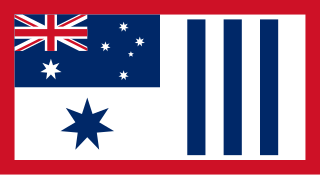 W
WThe Australian Honour Flag is a special Australian flag that was created by the Commonwealth Government in 1918, as a result of World War I. It consists of a white flag, with the national flag in canton, a large 7-pointed star, and three blue vertical bars, with a red border overall.
 W
WThe Australian Red Ensign resulted from the Commonwealth Government's 1901 Federal Flag Design Competition which required two entries: a flag for official Commonwealth Government use and another for the merchant navy. The winning design was based on the traditional British Red Ensign and featured the Southern Cross and Commonwealth Star.
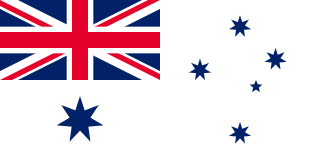 W
WThe Australian White Ensign is a naval ensign used by ships of the Royal Australian Navy (RAN) from 1967 onwards. From the formation of the RAN until 1967, Australian warships used the British White Ensign as their ensign. However, this led to situations where Australian vessels were mistaken for British ships, and when Australia became involved in the Vietnam War, the RAN was effectively fighting under the flag of another, uninvolved nation. Proposals were made in 1965 for a unique Australian ensign, which was approved in 1966, and entered use in 1967.
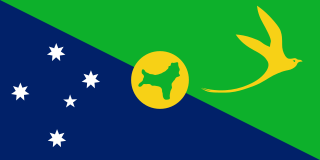 W
WThe flag of Christmas Island was unofficially adopted in 1986 after being chosen the winner in a competition for a flag for the territory. It was designed by Tony Couch of Sydney, Australia. The flag was made official on Australia Day, 2002 when the administrator of the territory, Bill Taylor, presented the flag to the Christmas Island Shire.
 W
WThe flag of the Cocos (Keeling) Islands was created in 2003 and adopted on 6 April 2004. It was designed by territory resident Mohammed Minkom, who won a design contest as a teenager.
 W
WThe Eureka Flag was flown at the Battle of the Eureka Stockade, which took place on 3 December 1854 at Ballarat in Victoria, Australia. It was the culmination of the 1851–1854 Eureka Rebellion on the Victorian goldfields, where miners protested against the cost of mining permits and the officious way the colonial authorities enforced the system along with other grievances. An estimated crowd of over 10,000 demonstrators swore allegiance to the flag as a symbol of defiance at Bakery Hill on 29 November 1854. Twenty-two miners were officially listed as killed at the Eureka Stockade, along with seven troopers and police. Around 120 miners were arrested, and many others badly wounded.
 W
WThe flag of Australia is based on the British maritime Blue Ensign – a blue field with the United Kingdom flag in the canton or upper hoist quarter – augmented with a large white seven-pointed star and a representation of the Southern Cross constellation, made up of five white stars – one small five-pointed star and four, larger, seven-pointed stars. There are other official flags representing Australia, its people and core functions of government.
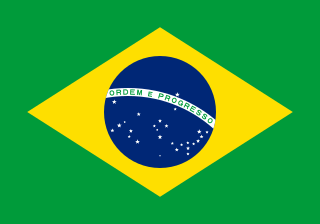 W
WThe flag of Brazil, known in Portuguese as Verde e amarela, or less usually Auriverde, is a blue disc depicting a starry sky spanned by a curved band inscribed with the national motto "Ordem e Progresso", within a yellow rhombus, on a green field. Brazil officially adopted this design for its national flag on November 19, 1889 — four days after the Proclamation of the Republic, to replace the flag of the Empire of Brazil. The concept was the work of Raimundo Teixeira Mendes, with the collaboration of Miguel Lemos, Manuel Pereira Reis and Décio Villares.
 W
WThe Flag of Magallanes y la Antártica Chilena Region is one of the regional symbols of the Chilean Magallanes y la Antártica Chilena Region. This flag was adopted in 1997 by the regional government, also with the Regional Coat of Arms.
 W
WThe Flag of New Zealand, also known as the New Zealand Ensign, is based on the British maritime Blue Ensign – a blue field with the Union Jack in the canton or upper hoist corner – augmented or defaced with four red stars centred within four white stars, representing the Southern Cross constellation.
 W
WThe flag of the governor-general of New Zealand is an official flag of New Zealand and is flown continuously on buildings and other locations when a governor-general is present. The flag in its present form was adopted in 2008 and is a blue field with the shield of the New Zealand coat of arms royally crowned. The official heraldic description is "A flag of a blue field thereon the Arms of New Zealand ensigned by the Royal Crown all proper".
 W
WThe current state flag of the Northern Territory was officially adopted by the Northern Territory, Australia, in 1978. The Northern Territory has been in existence since 1911, but did not hoist its first flag until self-government in 1978.
 W
WThe flag of Victoria, symbolising the state of Victoria in Australia, is a British Blue Ensign defaced by the state badge of Victoria in the fly. The badge is the Southern Cross surmounted by an imperial crown, which is currently the St Edward's Crown. The stars of the Southern Cross are white and range from five to eight points with each star having one point pointing to the top of the flag. The flag dates from 1870, with minor variations, the last of which was in 1953. It is the only Australian state flag not to feature the state badge on a round disc.
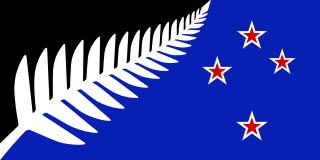 W
WThe black, white and blue silver fern flag is a proposed flag for New Zealand by architectural designer Kyle Lockwood. It was first designed using different colours in 2000. It was voted as the preferred alternative New Zealand flag in the first of two New Zealand flag referendums in December 2015, and was used in the second flag referendum in a binding contest against the current New Zealand flag. Despite a UMR poll predicting that the flag would earn only 35% of the vote, the Silver Fern Flag gained a significant minority in the March 2016 referendum with 43.2% of the vote, whilst the existing flag won with 56.6% of the vote.
 W
WThe New Zealand Civil Air Ensign is the flag that represents civil aviation in New Zealand.
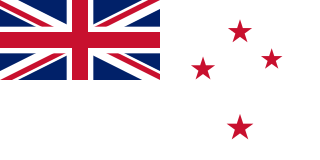 W
WThe New Zealand White Ensign is a naval ensign used by ships of the Royal New Zealand Navy (RNZN) from 1968. Based on the Royal Navy's White Ensign, it features the Southern Cross from the New Zealand national flag in place of the Saint George's Cross. One of the earliest flags associated with the country, that used by the United Tribes of New Zealand, was a white ensign. This was replaced by the Union Flag when New Zealand became a British colony. A blue ensign with the Southern Cross was introduced for ships of the colonial government in 1867 and this soon became a de facto national flag. Ships in New Zealand naval service wore the Royal Navy's White Ensign until 1968 when the distinct New Zealand White Ensign was introduced. The ensign was implemented out of a desire to distinguish New Zealand vessels from those of the Royal Navy and this decision is regarded as an important step in the development of the RNZN.
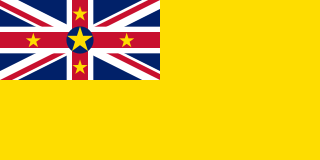 W
WThe flag of Niue was adopted on 15 October 1975. It consists of the Union Jack in the upper left corner with a star in the middle of the Union Jack and four stars forming a diamond around it. It is very unusual for a flag based on a British ensign design, in having not only a yellow background, but also a defaced (edited) Union Jack in the canton. It was designed by Patricia Rex, the wife of the then-Premier Robert Rex.
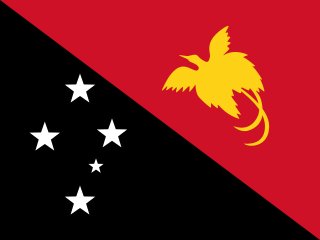 W
WThe flag of Papua New Guinea was adopted on 1 July 1971. In the hoist, it depicts the Southern Cross; in the fly, a raggiana bird-of-paradise is silhouetted. The design was chosen through a nationwide design competition in early 1971. The winning designer was Susan Karike, who was 15 at the time.
 W
WThe flag of Paraná, Brazil, was adopted on 9 January 1892. It went through changes in March 1947, and again in September, 1990.
 W
WThe personal flag of Queen Elizabeth II in her role as Queen of New Zealand was approved for use in 1962. It is used by the Queen when she is in New Zealand. The Queen's Representative, the Governor-General of New Zealand has their own flag.
 W
WThe Royal Australian Air Force Ensign is used by the Royal Australian Air Force and the Australian Air Force Cadets in Australia and overseas. It is based on the Australian national flag, with the field changed to Air Force blue, and the southern cross tilted clockwise to make room for the RAAF roundel inserted in the lower fly quarter. The roundel is a red leaping kangaroo on white within a dark blue ring. The ensign was proclaimed as a Flag of Australia under section 5 of the Flags Act on 6 May 1982.
 W
WThe flag of Samoa was first adopted from February 24, 1949 for UN Trusteeships, and continuously applied for the state's independence on January 1, 1962. It consists of a red field with a blue rectangle in the canton. The blue rectangle bears the Southern Cross: four large white stars and one smaller star.
 W
WAs Tokelau is a dependent territory of New Zealand, the flag of New Zealand has been used as the official flag for Tokelau. In May 2008, however, the local parliament, the General Fono, approved a distinctive flag and national emblem for Tokelau. This flag has not yet been widely used for official purposes, but an official launch of the new flag was planned for October 2009. The Governor-General presented the flag to the Ulu-o-Tokelau as Tokelau's first official flag on 7 September 2009.
 W
W